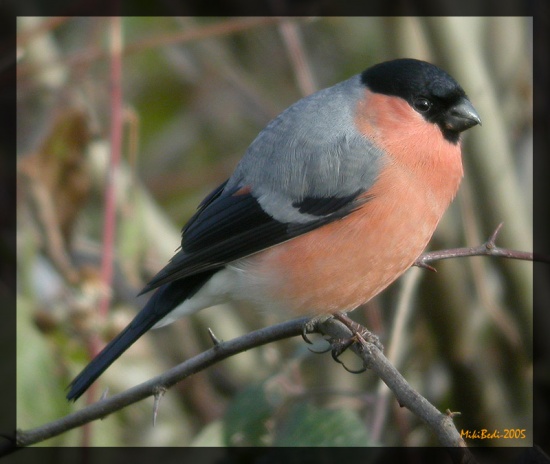- Pyrrhula pyrrhula
Includes: Grey Bullfinch; Ussuri Bullfinch
Identification
14·5–16 cm (5¾-6¼ in)
- Stocky finch
- Stubby bill
- Black face and cap
- White bar on black wings
- White rump
Males
Blue-grey upperparts and bright red underparts.
Males Ussuri Bullfinch (rosacea) with brown upperparts and grayish-red or grey (griseiventris) underparts;cheeks more intense rose coloration.
Males Grey Bullfinch (cineracea) with gray upperparts and underparts.
Females
Duller, with pinkish-brown underparts.
Old females Grey Bullfinch and P. p. cassinii with greyish or grey upperparts.
Juveniles
Similar to females, but do not acquire the black cap until after their first moult
Distribution
Widely distributed and common over much of range. Breeds throughout the British Isles and France, northern Spain east across Europe to the Urals including much of Scandinavia except the far north and higher mountains and north to the White Sea in Russia. Breeds south to the Mediterranean coast of France, northern Italy and the Balkans, northern Turkey and the Caucasus.
The range continues through Siberia to Manchuria (China) and northern Japan.
Migratory in far north of range, partial migrant or resident elsewhere, migrants move southwards in Oct-Nov, returning Mar-Apr. More widespread in winter, especially in Iberia, south and South-East Europe and Turkey.
Vagrants recorded in Iceland, Gibraltar, North-West Africa, Sicily and Malta, Jordan.
Taxonomy
Azores Bullfinch was formerly included in this species.
Subspecies
There are 9 or 10 subspecies:[1]:
- P. p. pileata on the British Isles
- Smaller than nominate, the male is darker grey above and duller pink below
- P. p. europoea in western and central Europe
- Very similiar to nominate but slightly smaller
- P. p. iberiae in southwest France and the mountains of northern Portugal and Spain
- More orange below in males with some red on the back and females paler above
- P. p. pyrrhula in northern, eastern and south-central Europe and east across Siberia (Verkhoyansk Mountains and Sea of Okhotsk), northeast Kazakhstan, northwest China and northern Mongolia. Winters to southern Europe and southwest and central Asia.
- P. p. rossikowi in Turkey, the Caucasus and northwest Iran
- Deeper, more reddish-pink below
- P. p. caspica in Azerbaijan and northern Iran
- P. p. cineracea in western, south-central and east Siberia, northeast Kazakhstan and northern Mongolia.Far East (eastern Amurland and Ussuriland). Probably also in northeast China. Winters to Sakhalin, northeast China, Korea - sometimes treated as full species, Grey Bullfinch or Baikal Bullfinch
- Male has completely grey underparts, sometime with slightly rosy
- P. p. cassinii in the Russian Far East (Western and northern shores of Sea of Okhotsk, southern Koryakland, Kamchatka and northern Kuril Islands), migrates to Amurland, Ussuriland, Alaska, Sakhalin and northeast China
- P. p. griseiventris in central and southern Kuril Islands and northern Japan, - sometimes treated as full species, Ussuri Bullfinch (or Oriental / Grey-bellied Bullfinch) together P. p. rosacea, which is also often included into griseiventris.
- Red restricted to throat and side of head in male, rest of underparts greyish.
Subspecies rosacea is not accepted by all authorities[2]

Photo by johnnyoxygen
Bunting hide, Pennington Flash Country Park, September 2010
Habitat
Woodland and open forest, usually deciduous but also coniferous in the north. Also on farmland with copses and hedgerows, orchards, gardens and town parks. Generally shy and secretive.
Behaviour
The flight is undulating.
Diet
Bullfinches have a broad diet, consisting mainly of the seeds and berries of a variety of plants. When these are scarce during the spring they turn to the buds of fruit trees. When bullfinches occurred in higher numbers they were considered to be pests of orchards.
Breeding
Nests are built in dense hedges and woods between four and seven feet from the ground. Fine twigs, moss and lichens are used to construct the main body of the nest and a lining of fine roots is added. In May 4-5 pale blue spotted eggs are laid, the female incubates the eggs for 12-14 days after which both parents feed the chicks. A further 12 to 16 days later the chicks fledge. A second brood is then usually produced.
Vocalisation
1: Includes a subdued piping warble.
2: P. cineracea call.
3: P. pyrrhula pyrrhula call. From Baikal
4: P. pyrrhula pyrrhula trumpeting call. From Altai
Recordings 2-4 by Vadim
Family group of adult & juvenile Bullfinches calling to each other
Leeds, Yorkshire, August 2016
Recording by Chris-Leeds
References
- Clements, J. F., T. S. Schulenberg, M. J. Iliff, D. Roberson, T. A. Fredericks, B. L. Sullivan, and C. L. Wood. 2016. The eBird/Clements checklist of birds of the world: v2016, with updates to August 2016. Downloaded from http://www.birds.cornell.edu/clementschecklist/download/
- Avibase
- Dickinson, EC, ed. 2003. The Howard and Moore Complete Checklist of the Birds of the World. 3rd ed., with updates to December 2007 (Corrigenda 7). Princeton: Princeton Univ. Press. ISBN 978-0691117010
- Gill, F, M Wright and D Donsker. 2009. IOC World Bird Names (version 2.0). Available at http://www.worldbirdnames.org/.
- Sibley, CG and BL Monroe. 1996. Birds of the World, on diskette, Windows version 2.0. Charles G. Sibley, Santa Rosa, CA, USA.
Recommended Citation
- BirdForum Opus contributors. (2024) Eurasian Bullfinch. In: BirdForum, the forum for wild birds and birding. Retrieved 25 April 2024 from https://www.birdforum.net/opus/Eurasian_Bullfinch
External Links
GSearch checked for 2020 platform.1







